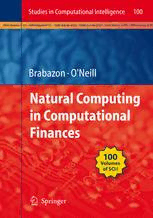Table Of ContentAnthonyBrabazonandMichaelO’Neill(Eds.)
NaturalComputinginComputationalFinance
StudiesinComputationalIntelligence,Volume100
Editor-in-chief
Prof.JanuszKacprzyk
SystemsResearchInstitute
PolishAcademyofSciences
ul.Newelska6
01-447Warsaw
Poland
E-mail:kacprzyk@ibspan.waw.pl
Furthervolumesofthisseriescanbefoundonour Vol.90.SimoneMarinaiandHiromichiFujisawa(Eds.)
homepage:springer.com MachineLearninginDocumentAnalysis
andRecognition,2008
Vol.78.CostinBadicaandMarcinPaprzycki(Eds.) ISBN978-3-540-76279-9
IntelligentandDistributedComputing,2008 Vol.91.HorstBunke,KandelAbrahamandLastMark(Eds.)
ISBN978-3-540-74929-5 AppliedPatternRecognition,2008
Vol.79.XingCaiandT.-C.JimYeh(Eds.) ISBN978-3-540-76830-2
QuantitativeInformationFusionforHydrological
Vol.92.AngYang,YinShanandLamThuBui(Eds.)
Sciences,2008
SuccessinEvolutionaryComputation,2008
ISBN978-3-540-75383-4
ISBN978-3-540-76285-0
Vol.80.JoachimDiederich
RuleExtractionfromSupportVectorMachines,2008 Vol.93.ManolisWallace,MariosAngelidesandPhivos
ISBN978-3-540-75389-6 Mylonas(Eds.)
AdvancesinSemanticMediaAdaptationand
Vol.81.K.Sridharan
Personalization,2008
RoboticExplorationandLandmarkDetermination,2008
ISBN978-3-540-76359-8
ISBN978-3-540-75393-3
Vol.82.AjithAbraham,CrinaGrosanandWitold Vol.94.ArpadKelemen,AjithAbrahamandYuehuiChen
Pedrycz(Eds.) (Eds.)
EngineeringEvolutionaryIntelligentSystems,2008 ComputationalIntelligenceinBioinformatics,2008
ISBN978-3-540-75395-7 ISBN978-3-540-76802-9
Vol.83.BhanuPrasadandS.R.M.Prasanna(Eds.) Vol.95.RaduDogaru
Speech,Audio,ImageandBiomedicalSignalProcessing SystematicDesignforEmergenceinCellularNonlinear
usingNeuralNetworks,2008 Networks,2008
ISBN978-3-540-75397-1 ISBN978-3-540-76800-5
Vol.84.MarekR.OgielaandRyszardTadeusiewicz Vol.96.Aboul-EllaHassanien,AjithAbrahamandJanusz
ModernComputationalIntelligenceMethods Kacprzyk(Eds.)
fortheInterpretationofMedicalImages,2008 ComputationalIntelligenceinMultimediaProcessing:
ISBN978-3-540-75399-5 RecentAdvances,2008
Vol.85.ArpadKelemen,AjithAbrahamandYulanLiang ISBN978-3-540-76826-5
(Eds.)
Vol.97.GloriaPhillips-Wren,NikhilIchalkaranjeand
ComputationalIntelligenceinMedicalInformatics,2008
LakhmiC.Jain(Eds.)
ISBN978-3-540-75766-5
IntelligentDecisionMaking:AnAI-BasedApproach,2008
Vol.86.ZbigniewLesandMogdalenaLes ISBN978-3-540-76829-9
ShapeUnderstandingSystems,2008
ISBN978-3-540-75768-9 Vol.98.AshishGhosh,SatchidanandaDehuriandSusmita
Ghosh(Eds.)
Vol.87.YuriAvramenkoandAndrzejKraslawski
Multi-ObjectiveEvolutionaryAlgorithmsforKnowledge
CaseBasedDesign,2008
DiscoveryfromDatabases,2008
ISBN978-3-540-75705-4
ISBN978-3-540-77466-2
Vol.88.TinaYu,DavidDavis,CemBaydarandRajkumar
Roy(Eds.) Vol.99.GeorgeMeghabghabandAbrahamKandel
EvolutionaryComputationinPractice,2008 SearchEngines,LinkAnalysis,andUser’sWebBehavior,
ISBN978-3-540-75770-2 2008
ISBN978-3-540-77468-6
Vol.89.ItoTakayuki,HattoriHiromitsu,ZhangMinjie
andMatsuoTokuro(Eds.) Vol.100.AnthonyBrabazonandMichaelO’Neill(Eds.)
Rational,Robust,Secure,2008 NaturalComputinginComputationalFinance,2008
ISBN978-3-540-76281-2 ISBN978-3-540-77476-1
Anthony Brabazon
Michael O’Neill
(Eds.)
Natural Computing
in Computational Finance
With79Figuresand61Tables
123
Dr.AnthonyBrabazon Dr.MichaelO’Neill
HeadofResearch-SchoolofBusiness Director-NaturalComputingResearch
QuinnSchool andApplications
UniversityCollegeDublin SchoolofComputerScienceandInformatics
Belfield,Dublin4 UniversityCollegeDublin
Ireland Belfield,Dublin4
anthony.brabazon@ucd.ie Ireland
m.oneill@ucd.ie
ISBN978-3-540-77476-1 e-ISBN978-3-540-77477-8
StudiesinComputationalIntelligenceISSN1860-949X
LibraryofCongressControlNumber:2008922057
(cid:1)c 2008Springer-VerlagBerlinHeidelberg
Thisworkissubjecttocopyright.Allrightsarereserved,whetherthewholeorpartofthematerial
isconcerned,specificallytherightsoftranslation,reprinting,reuseofillustrations,recitation,broad-
casting,reproductiononmicrofilmorinanyotherway,andstorageindatabanks.Duplicationof
thispublicationorpartsthereofispermittedonlyundertheprovisionsoftheGermanCopyrightLaw
ofSeptember9,1965,initscurrentversion,andpermissionforusemustalwaysbeobtainedfrom
Springer-Verlag.ViolationsareliabletoprosecutionundertheGermanCopyrightLaw.
Theuseofgeneraldescriptivenames,registerednames,trademarks,etc.inthispublicationdoesnot
imply, even in the absence of a specific statement, that such names are exempt from the relevant
protectivelawsandregulationsandthereforefreeforgeneraluse.
Coverdesign:Deblik,Berlin,Germany
Printedonacid-freepaper
9 8 7 6 5 4 3 2 1
springer.com
ToMaria
Tony
ToGra´inneand Aoife
Michael
Preface
The inspiration for this book stemmed from the success of EvoFin 2007, the first
EuropeanWorkshoponEvolutionaryComputationinFinanceandEconomics,which
washeldaspartoftheEvoWorkshopsatEvo*inValencia,SpaininApril2007.The
rangeandqualityofpaperssubmittedfortheworkshopunderscoredthesignificant
levelofresearchactivitywhichistakingplaceattheinterfaceofnaturalcomputing
and finance. After the workshop, a call for papers was issued for this volume and
following a rigorous, peer-reviewed, selection process a total of fourteen chapters
werefinallyselected.Thechapterswereselectedonthebasisoftechnicalexcellence
andasexamplesoftheapplicationofarangeofnaturalcomputingandagent-based
methodologies to a broad array of financial domains. The book is intended to be
accessible to a wide audience and should be of interest to academics, students and
practitionersinthefieldsofbothnaturalcomputingandfinance.
We would like to thank all the authors for their high-quality contributions and
we would also like to thank the reviewers who generously gave of their time to
peer-review all submissions. We also extend our thanks to Dr. Thomas Ditzinger
ofSpringer-VerlagandtoProfessorJanuszKacprzyk,editorofthisbookseries,for
theirencouragementofandtheirsupportduringthepreparationofthisbook.
Dublin AnthonyBrabazon
December2007 MichaelO’Neill
Contents
1 NaturalComputinginComputationalFinance:AnIntroduction
AnthonyBrabazonandMichaelO’Neill................................ 1
PartI Optimisation
2 ConstrainedIndexTrackingunderLossAversionUsingDifferential
Evolution
DietmarMaringer................................................. 7
3 AnEvolutionaryApproachtoAssetAllocationinDefinedContribution
PensionSchemes
KeremSenel,A.BulentPamukcu,SerhatYanik .......................... 25
4 EvolutionaryStrategiesforBuildingRisk-OptimalPortfolios
PiotrLipinski .................................................... 53
5 EvolutionaryStochasticPortfolioOptimization
RonaldHochreiter................................................. 67
6 Non-linearPrincipalComponentAnalysisoftheImpliedVolatility
SmileusingaQuantum-inspiredEvolutionaryAlgorithm
KaiFan,ConallO’Sullivan,AnthonyBrabazon,MichaelO’Neill ........... 89
7 Estimation of an EGARCH Volatility Option Pricing Model
usingaBacteriaForagingOptimisationAlgorithm
JingDang,AnthonyBrabazon,MichaelO’Neill,DavidEdelman............109
PartII ModelInduction
8 Fuzzy-EvolutionaryModelingforSingle-PositionDayTrading
Ce´liadaCostaPereira,AndreaG.B.Tettamanzi ........................131
X Contents
9 StrongTyping, VariableReductionandBloatControlforSolving
theBankruptcyPredictionProblemUsingGeneticProgramming
EvaAlfaro-Cid,AlbertoCuesta-Can˜ada,KenSharman,
AnnaI.Esparcia-Alca´zar ...........................................161
10 UsingKalman-filteredRadialBasisFunctionNetworksforIndex
ArbitrageintheFinancialMarkets
DavidEdelman ...................................................187
11 On Predictability and Profitability: Would GP Induced Trading
RulesbeSensitivetotheObservedEntropyofTimeSeries?
NicolasNavet,Shu-HengChen ......................................197
12 HybridNeuralSystemsinExchangeRatePrediction
AndrzejBielecki,PawelHajto,RobertSchaefer..........................211
PartIII Agent-basedModelling
13 EvolutionaryLearningoftheOptimalPricingStrategyinanArtificial
PaymentCardMarket
BilianaAlexandrova-Kabadjova,EdwardTsang,AndreasKrause ...........233
14 Can Trend Followers Survive in the Long-Run? Insights
fromAgent-BasedModeling
Xue-ZhongHe,PhilipHamill,YouweiLi ...............................253
15 Co-EvolutionaryMulti-AgentSystemforPortfolioOptimization
RafałDrez˙ewski,LeszekSiwik .......................................271
Index ............................................................. 301
1
Natural Computing in Computational Finance:
An Introduction
AnthonyBrabazonandMichaelO’Neill
NaturalComputingResearchandApplicationsGroup,UCDCASL,UniversityCollege
Dublin,Dublin,Ireland.anthony.brabazon@ucd.ie, m.oneill@ucd.ie
1.1 Introduction
Natural computing can be broadly defined as the development of computer pro-
grams and computational algorithms using metaphorical inspiration from systems
andphenomenathatoccurinthenaturalworld.Theinspirationfornaturalcomput-
ing methodologies typically stem from real-world phenomena which exist in high-
dimensional, noisy and uncertain, dynamic environments. These are characteristics
which fit well with the nature of financial markets. Prima facie, this makes natural
computingmethodsinterestingforfinancialmodellingapplications.Anotherfeature
ofnaturalenvironmentsisthephenomenonofemergence,ortheactivitiesofmulti-
pleindividualagentscombiningtocreatetheirownenvironment.
Thisbookcontainsfourteenchapterswhichillustratethecutting-edgeofnatural
computingandagent-basedmodellinginmoderncomputationalfinance.Arangeof
methodsareemployedincluding,DifferentialEvolution,GeneticAlgorithms,Evo-
lution Strategies, Quantum-Inspired Evolutionary Algorithms, Bacterial Foraging
Algorithms, Genetic Programming, Agent-based Modelling and hybrid approaches
including Fuzzy-Evolutionary Algorithms, Radial-Basis Function Networks with
Kalman Filters, and a Multi-Layer Perceptron-Wavelet hybrid. A complementary
rangeofapplicationsareaddressedincludingFundAllocation,AssetPricing,Market
Prediction, Market Trading, Bankruptcy Prediction, and the agent based modelling
ofpaymentcardandfinancialmarkets.
Thebookisdividedintothreesectionseachcorrespondingtoadistinctgrouping
of chapters. The first section deals with optimisation applications of natural com-
putinginfinance,thesecondsectionexplorestheuseofnaturalcomputingmethod-
ologies for model induction and the final section illustrates a range of agent-based
applicationsinfinance.
A.BrabazonandM.O’Neill:NaturalComputinginComputationalFinance:AnIntroduction,StudiesinComputational
Intelligence(SCI)100,1–4(2008)
www.springerlink.com (cid:1)c Springer-VerlagBerlinHeidelberg2008
2 A.BrabazonandM.O’Neill
1.2 Optimisation
A wide variety of natural computing methodologies including genetic algorithms,
evolutionary strategies, differential evolution and particle swarm optimisation have
been applied for optimisation purposes in finance. A particular advantage of these
methodologies is that, applied properly, they can cope with difficult, multi-modal,
error surfaces. In the first six chapters, a series of these algorithms are introduced
andappliedtoavarietyoffinancialoptimisationproblems.
Passive portfolio management strategies have become very common in recent
decades. In spite of the apparent simplicity of constructing an asset portfolio in
order to track an index of interest, it is difficult to do this in practice due to the
dynamic nature of the market and due to transactions constraints. As discussed in
chpt.2(ConstrainedIndexTrackingunderLossAversionUsingDifferentialEvolu-
tionbyDietmarMaringer),thesolutionspaceisnon-convexsuggestingausefulrole
forpopulation-based,globaloptimisation,heuristicslikedifferentialevolution.This
chapterappliesdifferentialevolutionforassetselectioninapassiveportfolio.
The issue of optimal asset allocation for defined contribution pension funds is
addressedinchpt.3(AnEvolutionaryApproachtoAssetAllocationinDefinedCon-
tributionPensionSchemesbyKeremSenel,BulentPamukcuandSerhatYanik).To
date,therehavebeenfewexamplesofapplicationsofnaturalcomputinginthepen-
sionsdomain.Chpt.3showstheapplicationofthegeneticalgorithmforassetallo-
cationinapensionfund.
Theclassicalportfoliooptimisationproblemistackledusingevolutionarystrate-
giesinchpt.4(EvolutionaryStrategiesforBuildingRisk-OptimalPortfoliosbyPiotr
Lipinski). A particular advantage when using evolutionary algorithms for this task
is that a modeller can easily employ differing risk measures and real-world invest-
mentconstraintswhendeterminingoptimalportfolios.Thischapterprovidesaclear
illustrationofhowthiscanbedone.
Avariantonclassicalportfoliooptimisationisprovidedinchpt.5(Evolutionary
Stochastic Portfolio Optimization by Ronald Hochreiter). This chapter focusses on
stochastic portfolio optimisation and combines theory from the fields of stochastic
programming,evolutionarycomputation,portfoliooptimisation,aswellasfinancial
riskmanagementinordertoproduceageneralisedframeworkforcomputingoptimal
portfoliosunderuncertaintyforvariousprobabilisticriskmeasures.
Aconsiderableamountofresearchhasbeenundertakeninrecentyearsinorderto
improvethescalabilityofevolutionaryalgorithms.Thishasledtothedevelopment
of several new algorithms and methodological approaches including the compact
genetic algorithm and estimation of distribution algorithms (see chpt. 13 for an in-
troductiontoEDAs).Oneinterestingavenueofthisworkhasseenthemetaphorical
combination of concepts from evolution and quantum mechanics to form the sub-
fieldofquantum-inspiredevolutionaryalgorithms(QIEA).Chpt.6(Non-linearPrin-
cipalComponentAnalysisoftheImpliedVolatilitySmileusingaQuantum-inspired
EvolutionaryAlgorithm byKaiFanetal)providesanintroductiontothisareaand
illustrates the application of a QIEA for the purposes of undertaking a non-linear
principalcomponentanalysisoftheimpliedvolatilitysmileofstockoptions.

